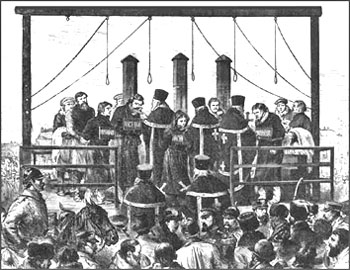![]()
What you must do in this unit
- Read the textbook pages 338-41 and 415-18.
- Check the remarks by Professor Blois and Professor Evans on the growth of the revolutionary movement.
- Study the Questions to Consider and the Key Terms for the Unit.
What you can do this unit
- Read some comments by George Kennan and Lev Deutsch on the tsarist government's practice of Siberian exile
- Read chapter 25 from Mary Platt Parmele (1843-1911) A Short History of Russia (1907, 4th edition). This is optional reading.
- In 1980 Professor Abbott Gleason published his engaging work on the Russian revolutionary movement, Young Russia: The Genesis of Russian Radicalism in the 1860s. Read some of Gleason's reflections on how he became interested in studying Russia and then later writing about the Russian radicals. (in *.doc or *.PDF format.)
Some videos that you can watch for this unit
- For extra credit please suggest to your instructor a relevant video for this unit of the course. Send the title of the video, the URL and a brief explanation of why you find the video interesting and applicable to the material that is being studied in this unit.
Extra Credit Options
- For up to 50 points of extra credit, submit the Russian culture paper for extra credit.
- For up to 25 points of extra credit, read Franco Venturi, Roots of Revolution: A History of the Populist and Socialist Movements in 19th-Century Russia (Rev. Ed., 2001), one of the greatest scholarly works ever written about Russia--and it was written by an Italian--and write a one-page paper in which you explain the origins and development of the Russian populist movement.
- For up to 25 points of extra credit, read Fedor Dostoevskii, Notes from the Underground (1864) and write a one-page paper that provides insight into Russian society of the 1840s. There are some truly memorable scenes in the book, especially one involving a five-ruble note.
- For up to 25 points of extra credit, read Fedor Dostoevskii (1821-81), The Devils (1872) and write a one-page paper explaining his portrait of the Russian revolutionaries.
- For up to 25 points of extra credit, read E. H. Carr, The Romantic Exiles: A Nineteenth-Century Portrait Gallery (1933) and write a one-page paper in which you look at the personal side of the lives of the Russian revolutionaries. This is a great book!
- For up to 25 points of extra credit, read Nikolai Chernyshevskii, What Is To Be Done? (1863-65) and write a one-page paper in which you answer the question, "What was Chernyshevskii's answer to the question that he posed?"
- For up to 10 points of extra credit, read Sergei Nechaev's Catechism of a Revolutionary and write a paragraph that answers the question, What was the underlying political philosophy of Nechaev?
Unit Learning Objectives
- Upon successful completion of this unit, you will be able to (1) explain the development of the revolutionary movement in Russian in the 1860s and 1870s, (2) identify key figures of the movement and (3) explain some of the main ideologies that motivated the revolutionaries.
